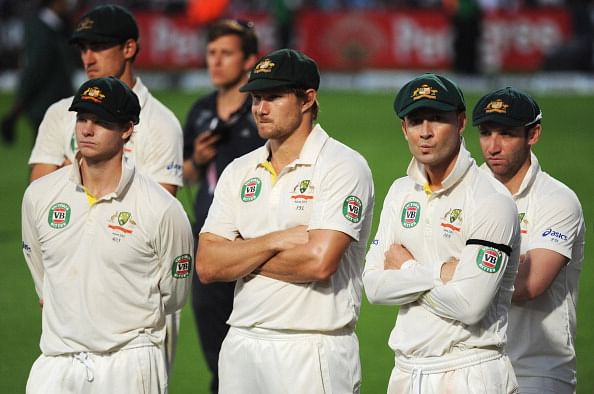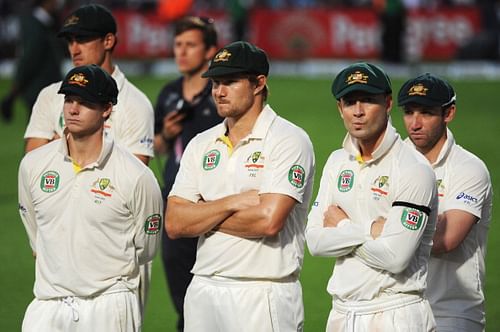
The Ashes 2013: Australia - A case of muddled thinking

Down and out: Michael Clarke (2ndR) looks dejected with teammates Steve Smith, Shane Watson and Phil Hughes during presentation after the 5th Ashes Test at the Oval on August 25, 2013 in London, England. (Getty Images)
“This is the worst side to leave the Australian shores for an Ashes series.”
Not for the first time, and certainly not for the last time, the English media seemed dismissive of the touring Australian side even before the series had begun.
Before Michael Clarke‘s men, few other Australian Ashes teams have also been subjected to this ignominious distinction.
Bob Simpson in 1964, Ian Chappell in 1972 and Allan Border in 1989 have previously led young sides into an Ashes series, which were touted to face heavy defeats but each of those teams punched above their weight to shock their opponents.
While the unfancied Australian team in ’64 played with a lot of grit and courage to force four draws and eke out one win, in ’72 Chappell and his inexperienced side competed with flair and valour against a strong English side in an exciting series, which ended in a 2-2 verdict. Border’s men went one step further and caused a major Ashes upset to register a thumping 4-0 win.
The current squad, though, couldn’t conjure up any such magic and, as had been widely predicted, came second best in the series. They showed major improvement, especially in the last three Tests, and were lauded for their whole-hearted and enterprising cricket, but despite all their efforts they ended with a 0-3 verdict against them. Their inexperience also came to the fore as despite running England close on several occasions, they lost the battle at decisive junctures.
So what does the autopsy report say?
On the scale of talent, the Australian batting unit is definitely below England; a major factor that significantly hampered the campaign was the constant chopping and changing they carried out. On several occasions, their thought process looked muddled and certain selections were made with a hope that things will work out.
In fact, in no two consecutive Tests did Australia employ the same set of batsmen in the same order and ended up using as many as 17 different players in the series. The story was no different in the recent whitewash against India, where 16 different men were tried out in the four match series.
Often successful teams are built around players who play together for a long period of time and forge a sense of trust among themselves. Such inconsistency in selection was bound to breed instability and affect the team adversely.
On the other hand, the victorious English side stuck to the same set of six batsmen for four Tests and, at least officially, Johnny Bairstow was dropped in the fifth Test only to accommodate a third seaming option.
Ed Cowan, who did relatively well as an opener in India, was forced down to the number three slot and was dropped after facing failure in just one Test. Phillip Hughes scored a half century against all odds at number six in the first Test but was pushed up to number four in the line-up for the second Test before being dropped from the playing XI.